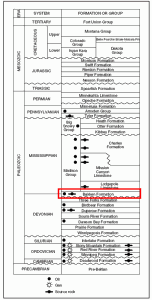This is a post by Piccolo, a petroleum engineer working in the petroleum industry.
 The Bakken formation in North Dakota and Montana has generated a lot of buzz in the past year. Reserve numbers in the billions of barrels, even tens or hundreds of billions show up in press reports and blogs. Now the USGS has weighed in with a comprehensive assessment of the resource. So just how much will this oil accumulation help the world’s largest importer of oil? Is it time to relax or is this just another small blip in the long-term decline of domestic production? We’ll examine these questions and others below the fold, using data from the IHS database.
The Bakken formation in North Dakota and Montana has generated a lot of buzz in the past year. Reserve numbers in the billions of barrels, even tens or hundreds of billions show up in press reports and blogs. Now the USGS has weighed in with a comprehensive assessment of the resource. So just how much will this oil accumulation help the world’s largest importer of oil? Is it time to relax or is this just another small blip in the long-term decline of domestic production? We’ll examine these questions and others below the fold, using data from the IHS database.
Figure 1 – Location of the Bakken Formation in the Williston Basin, adapted from esask.uregina.ca/entry/williston_basin
Overview of the Bakken
The Bakken formation is an oil-bearing strata covering parts of Montana, North Dakota, and Saskatchewan. Oil was first produced from the Bakken more than 50 years ago. Production was mainly from a few vertical wells until the 1980’s when horizontal technology became available. Only recently after the intensive application of horizontal wells combined with hydraulic fracturing technology did production really take off.
 The Bakken is one of many hydrocarbon producing formations in the Williston Basin, a sedimentary basin covering parts of three states and two provinces. The total layer of sediments in the basin can be up to 15,000 ft thick, and within that, the Bakken itself reaches a maximum thickness of about 150 ft., but is thinner in most areas. The depth to the top of the Bakken can vary from a few thousand feet in Canada to more than 10,000 feet in the deeper areas in North Dakota. In terms of geologic age, it was deposited during the upper Devonian and Lower Mississippian periods about 360 million years ago. The entire stratigraphic column for the Williston Basin is shown below. Figure 2 indicates 15 primary producing formations in the basin, including the Bakken.
The Bakken is one of many hydrocarbon producing formations in the Williston Basin, a sedimentary basin covering parts of three states and two provinces. The total layer of sediments in the basin can be up to 15,000 ft thick, and within that, the Bakken itself reaches a maximum thickness of about 150 ft., but is thinner in most areas. The depth to the top of the Bakken can vary from a few thousand feet in Canada to more than 10,000 feet in the deeper areas in North Dakota. In terms of geologic age, it was deposited during the upper Devonian and Lower Mississippian periods about 360 million years ago. The entire stratigraphic column for the Williston Basin is shown below. Figure 2 indicates 15 primary producing formations in the basin, including the Bakken.
Figure 2 – Williston Basin stratigraphic column from Wikipedia
To learn more about the intricacies of the Bakken, continue reading here.





